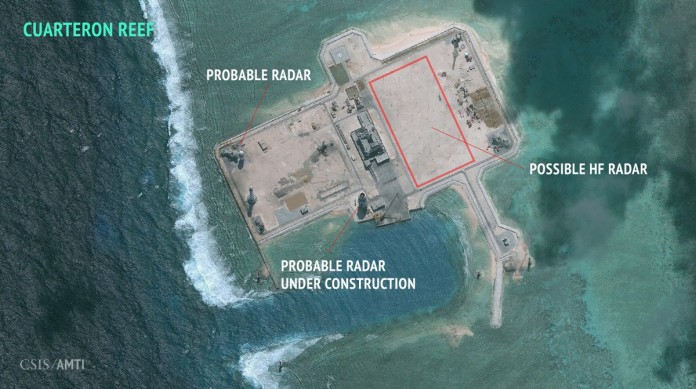China continues its force buildup across islands throughout the South China Sea. A study compiled by Asia maritime Transparency Initiative (AMTI) of the Center for Strategic & International Studies (CSIS) unveiled new installations and preparations on a number of islands.
Apart from air strips and air defense sites reported in the larger islands, China is actively deploying permanent airspace and maritime surveillance capabilities at its smaller Spratly Island outposts—Gaven, Hughes, Johnson South, and especially Cuarteron reefs—will prove equally important to Beijing’s long-term strategy. Improved radar coverage is an important piece of the puzzle—along with improved air defenses and greater reach for Chinese aircraft—toward China’s goals of establishing effective control over the sea and airspace throughout the nine-dash line.
New radar facilities at Cuarteron Reef, the southernmost of China’s occupied features in the South China Sea, are particularly important. Construction of facilities at Cuarteron seems nearly complete and the artificial island now covers about 52 acres (211,500 square meters). Two probable radar towers have been built on the northern portion of the feature, and a number of 65-foot (20-meter) poles have been erected across a large section of the southern portion. These poles could be a high-frequency radar installation, which would significantly bolster China’s ability to monitor surface and air traffic across the southern portion of the South China Sea. In addition to these radar facilities, China has constructed a buried bunker and lighthouse on the northern portion of the feature, a number of buildings and a helipad in its center, communications equipment to the south, and a quay with a loading crane on the western end of the outpost.
How these three capabilities overlap is highlighted in the interactive above. For illustrative purposes, radar ranges are shown as 300 kilometers from Cuarteron Reef and 50 kilometers from other features known to have likely radar towers. Fighter ranges are shown based on China’s J-10. To toggle each layer on and off, click on the dropdown box in the upper-right of the graphic.




















